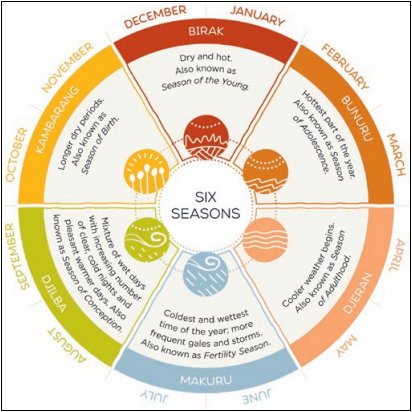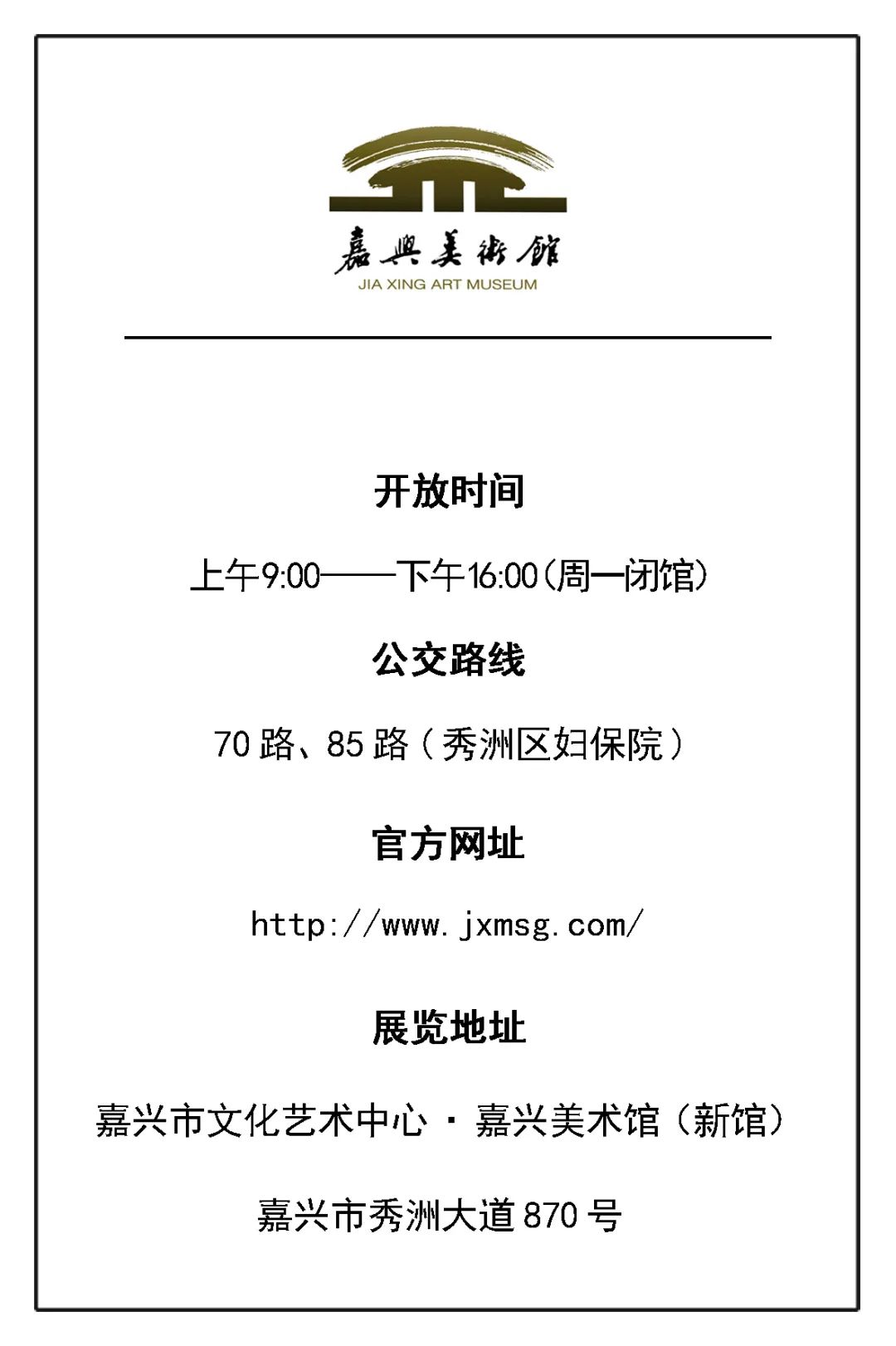A Letter from the Mayor of Bunbury
Over the twenty-two years that Bunbury and Jiaxing have been friendship cities. There have been many business and government delegations in addition to many exchanges in culture and education. Both cities have benefited from the exchange of cultures which has brought us closer together in friendship and understanding.
This collection of Noongar paintings is in response to the Modern Folk Paintings of Xiuzhou which were sent to Bunbury from China as a celebration of our time together as Friendship cities.These paintings were originally intended to be shipped to Jiaxing for exhibition, but are now exhibited online due to Covid regulations.
The local Noongar artists featured in this collection have drawn from their personal knowledge and cultural experiences with connection to country, their families, their stories, and their individual and shared histories. This has resulted in a beautiful collection that shows the deep connection to country and living culture.
We are deeply honoured that the artists from China and from the Bunbury Geographe Region have participated in this artistic exchange and interpretation of their respective homes.
自22年前班布里市与嘉兴市缔结国际友好城市关系以来,双方在文化、教育、经贸、高层互访等领域持续开展交流与合作,增进了情谊,深化了理解。
此前,班布里市曾展出过秀洲农民画作品,作为回应,在当前实物运输困难的情况下,两市共同策划了本次线上努加族艺术作品展。
努加族艺术家的创作灵感源于个人知识和文化经历,与土地、家庭、故事、艺术家个人经历及共同历史息息相关,这些画作表达了它们与土地以及生生不息的文化紧密相连。
今天,中国和班布里地区的艺术家们能够参与本次艺术交流并阐述各自对艺术的想法,我们对此深感荣幸。
杰森·米格尔
班布里市市长
A Letter from the Wadandi Noongar Elder
Kaya, wandju to our collection of 20 artworks from Artists residing on Wadandi Noongar Country, Bunbury Geographe Western Australia.
We invite you to enjoy this collection of work that each artist has responded to in looking at how we represent Noongar Country. The concept of Country here in our Culture is wrapped in our identity as Aboriginal Australians. As artists we have responded to the land, the elements, the ocean, the native animals and the seasonal wildflowers. Each painting has a story that interprets these elements that are important to each artist and their cultural identity.
Our stories are connected to the six seasons and legend. Our land brings different foods and medicines, the elements of rain, wind, cold, heat; knowledge that has been passed from generation to generation.
We come from country. We share our country and our way of speaking for our country.We are happy to send the spirit and heart from our place, Wadandi Country to your Country as a gift sent across the waters.
Lera Bennell,
Elder and Traditional Owner Wadandi Noongar Country,on behalf of the participating artists.
努加族沃当长老致信(译文)
欢迎欣赏来自西澳大利亚州班布里乔格拉菲的努加族沃当土地艺术家画集。
艺术家们通过画作表达了对沃当土地的理解。我们澳大利亚原住民的身份蕴含了关于土地的概念。作为艺术家,我们通过绘画展现了土地、元素、海洋、本土动物和季节性野花。每幅画都有一个故事,讲述了这些元素对每位艺术家及其文化身份的重要性。
我们的故事与六个季节和传说有关。土地赐予了我们各种食物、药物及雨、风、冷、热等元素,这些知识得以世代相传、生生不息。
我们来自这片土地,分享这片土地,通过绘画表达土地。我们也很高兴能从沃当土地把表达精神和情感的礼物传递到贵国。
莱拉·本内尔
努加族沃当土地长老和传统根脉者
谨代表参展艺术家
- Online Exhibition -
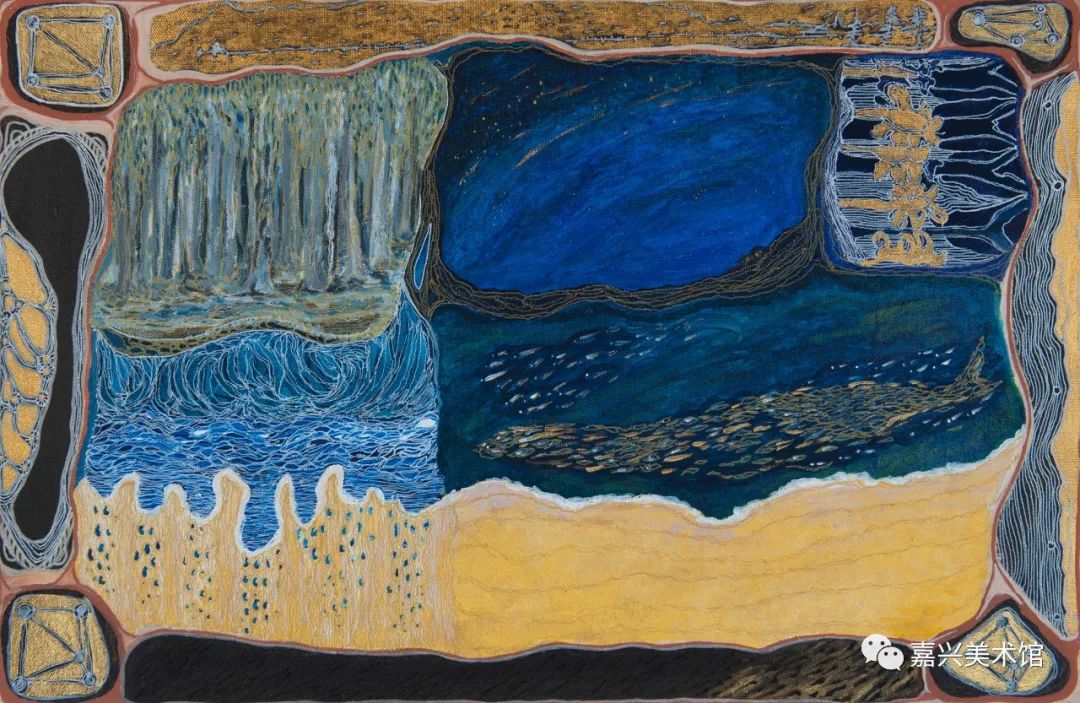
作者:Amanda Bell
作品:海洋风情
作者出生在一座海边小镇,后移居到沃当生活。作者希望通过作品表达对出生地的深厚感情。这幅画主要呈现海滨家乡的湿地、桉树林、白杨林、各色野花以及散落在海岸线的碎石。作者充分运用了海岸、海湾和天空的色彩,并在画的四角绘制了澳大利亚国旗上的“南十字星”。此外,作者通过金色表达了故乡对自己和其他原住民的重要性。
Amanda Bell
Wadan Djerabiny (Ocean Love)
I was born by the sea in Whadjuk Country and came to live by the sea on Wadandi land. In this painting, I represent that place where I grew up, and how special it is to me.
The Tuart forest, poplar trees, fantastic wildflowers, the coastal rocks that are scattered on our coastline, the Wonnerup wetlands and Undalup; my town by the sea, are all represented in this painting.
I use the colours of the coast and the bay, the shore, and the sky. The Southern Cross, a collection of stars which float in our southern sky, and on our national flag is represented in each corner.
I have also used lots of gold to give a sense of how precious this place is to me, and all who live here.
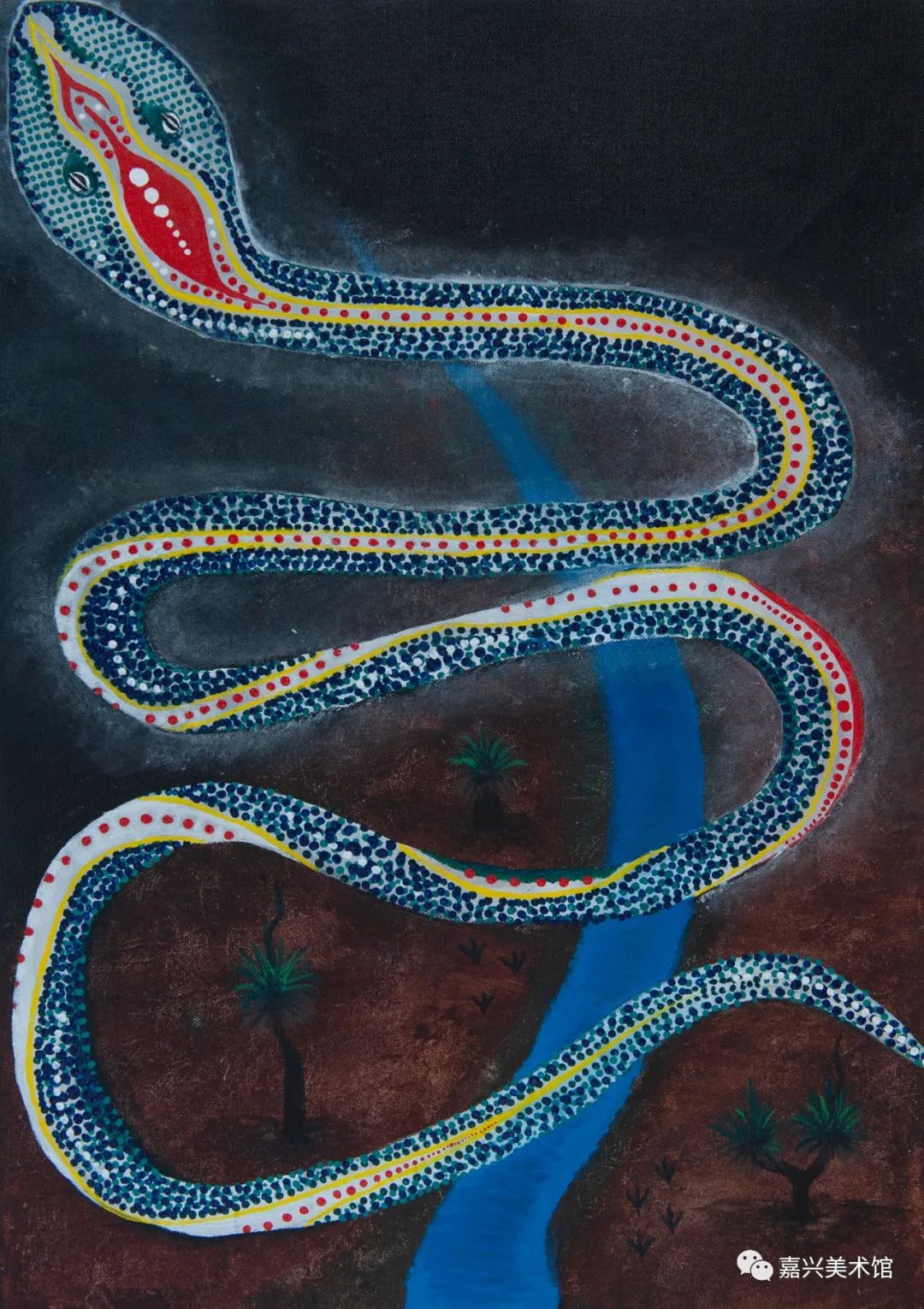
作者:Brady Haeusler
作品:彩虹蛇
作品中的彩虹蛇是澳大利亚原住民信奉的动物,通常栖息在水坝、水塘等水源附近。宝贵的水资源是动植物生存、繁衍的源泉。
Brady Haeusler
The Rainbow Serpent
The Rainbow serpent slithers and slides across Australia leaving behind rivers, dams and water holes which bring water there for life to the land. Feeding the animals and plants of the Australian wildlife.
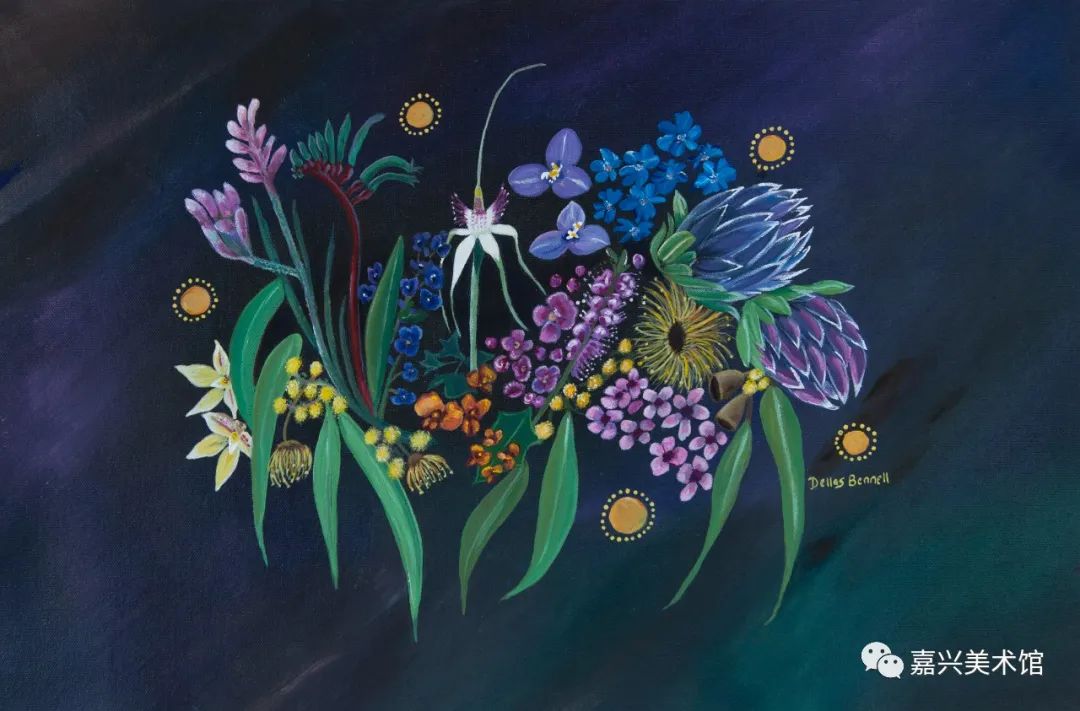
作者:Dellas Bennell
作品:野花季节
原住民生活的土地有六个季节,其中野花生长的季节是一年中探寻、欣赏野花最好的阶段。作者在步行欣赏野花途中,与家人谈论起野花的食用、药用价值,这方面的知识已实现代代相传。作品以白兰花为中心,绘制了14类不同品种的野花。
Dellas Bennell
Djilba Wildflowers
The Noongar Season of Djilba is a happy time with our mothers and grandmothers, walking through the bush looking for wildflowers.
Along the way we share stories of their use for food and medicine, this valuable knowledge has been passed down for generations.
There are 14 varieties of wildflowers in my painting, with the star being the white spider orchid.
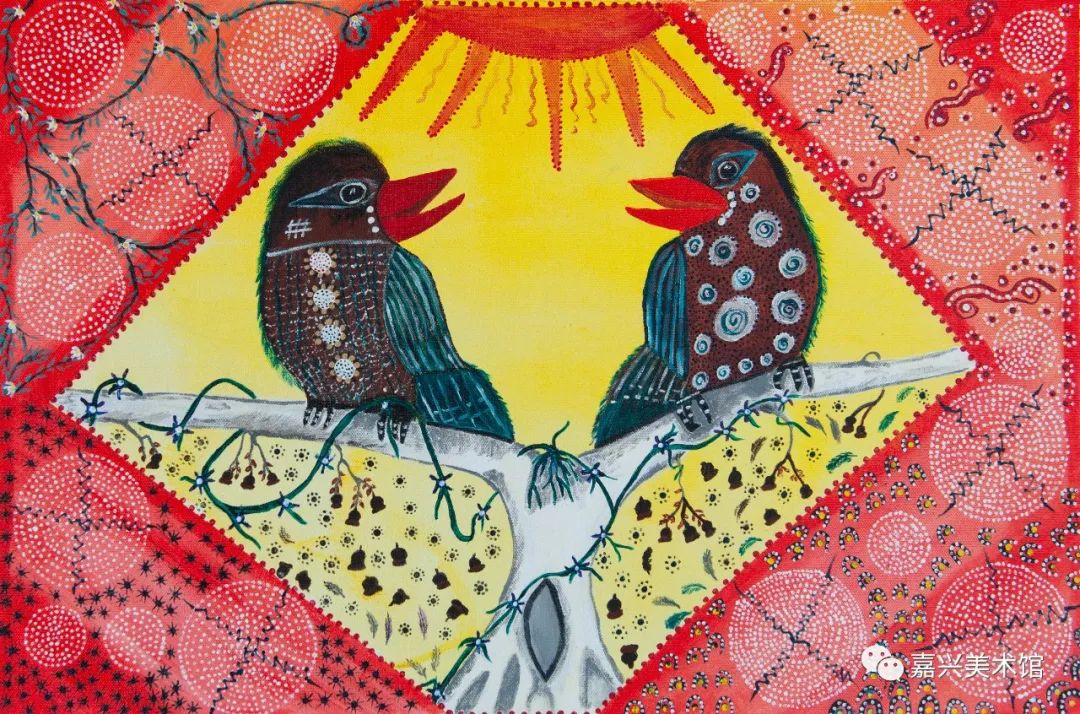
作者:Erica Anthony
作品:欢笑的笑翠鸟
笑翠鸟是翠鸟科中体型较大的一种鸟类。笑翠鸟发出类似笑声的声音时并没有笑,而是在保卫自己领地。作品中的两只笑翠鸟,看到两个小男孩在捉一只蜥蜴,面对面情不自禁的发出了笑声。澳大利亚原住民认为,祖先在“黄金时代”开垦荒地、创造生命,他们以神灵的形式永生。人类是自然的一部分,与所有其它生物息息相关。很多关于原住民祖先的传说,以故事、艺术、歌曲等形式流传至今。
Erica Anthony
The Laughing Kookaburra
The laughing kookaburra is not really laughing when it makes its familiar call. The cackle of its laughter is actually a territory call to warn other birds to stay away. It is a large Kingfisher.
It is said two little boys were playing a trick on a lizard. The two birds looked at each other and started to laugh, and then that is how they began to laugh.
Dreamtime or Dreaming for Australian Aboriginal people represents the time when the Ancient Spirits progressed over the land and created life and important physical and geographic formations and sites.

作者: Joanne Ugle
作品:手工编织的草碗
原住民编织草碗、草篮的传统方法,通常使用禾木胶树叶、棕榈树叶、芦苇草,以及毛发。编好的篮子既可以用来盛放日常物品,也可以作为过滤棕榈树种子毒素的容器。将放置有棕榈树种子的草碗,放在草篮里,浸入流水中,让潺潺流水带走种子里的毒素。作者的祖母通常使用禾木胶树的叶子来编织草碗,编织过程中使用拇指指甲来裁切叶子尺寸。这种手工技术,也常被用来编织毯子和垫子。在这幅作品中,作者选取编织草碗的一个场景,来展示这种手工艺,同时表达对其祖母的思念。
Joanne Ugle
Making a Grass Bowl
The grass bowl or basket would traditionally be made with Balga (grass tree) leaves, Boyoo (Zamia palm) leaves, grass reeds and even hair.
The basket can be used to carry things, some baskets were used to holds seeds in running water. Boyoo (Zamia palm) seeds are normally toxic. Soaking in water for a few days removes the toxicity, the grass basket was used was used to hold seeds while they soaked.
My grandmother used to make bowls from Boyoo leaves. She would use her thumbnail to cut/ strip the leaves into the right size and weave them together. This technique can be used for making mats for bedding or sitting on.
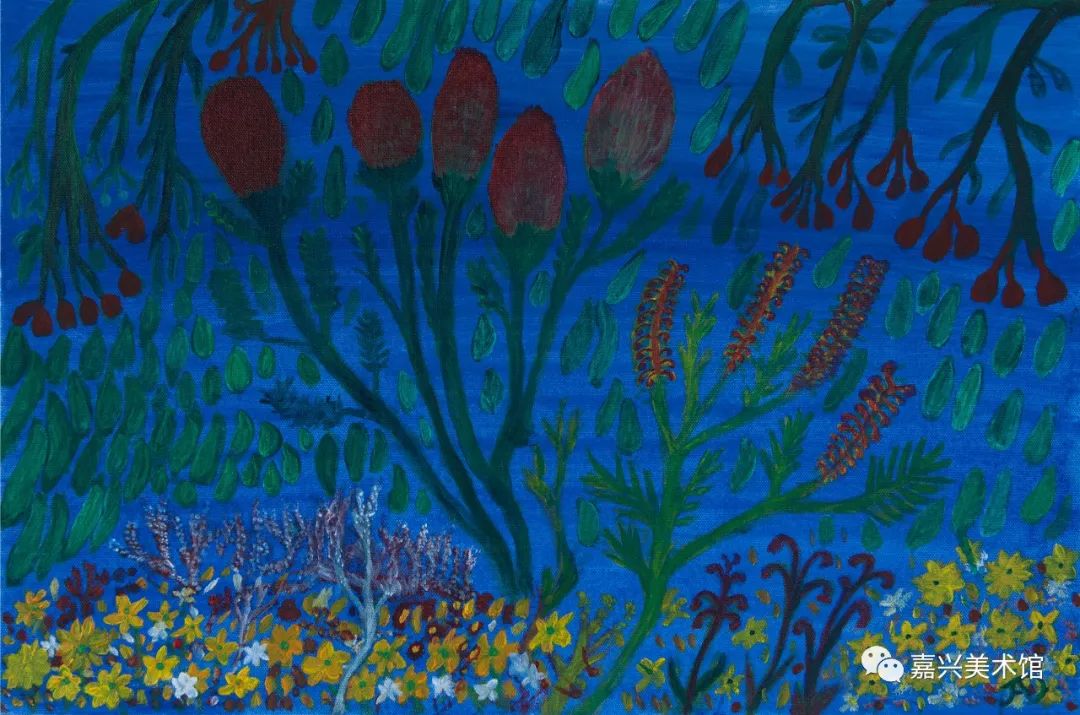
作者:Joyce Dimer (1954-2020)
作品:野花
作品的灵感源于西澳州绚丽的野花。作者以桉树叶作为画面背景,选取具有代表性的山龙眼、桉树花等野花进行创作。作者是一位原住民长者,也是一位优秀的艺术家,出生于西澳州平格利,在班布里市定居。
Joyce Dimer [1954 - 2020]
Wildflowers
Featuring the Banksia, Gum nuts, Kangaroo paws and smaller wildflowers.

在夕阳西下的傍晚,生活在作者家乡的鸸鹋在回家的路上翩翩起舞。作品的主要色彩为红色、黄色和黑色。作者希望通过这些颜色来展现夕阳美及原住文化与中华文明的相通之处。在原住文化中,红色代表土地,黄色代表太阳和生命,黑色代表人们、部落和国家。在中华文明中,红色象征幸福、喜庆和成就,黄色代表辉煌大地,黑色象征庄严肃穆。
Korrine Bennell
Wetj Makuru
As the sun goes down in Wardandi Boodja, the wetj dances through the clearing as it makes its way home during Makuru. Wardandi is my tribe and Boodja my land. Makuru is the winter season. Wetj is the Noongar word for Emu, a large flightless bird that has a strong foundation in Noongar culture and customs.
My painting features three colours: Red, Black and Yellow. Not only do these colours depict a sunset but also are cross-cultural by representing culture for both Noongar and Chinese. These colours are a huge part of identity and belonging.
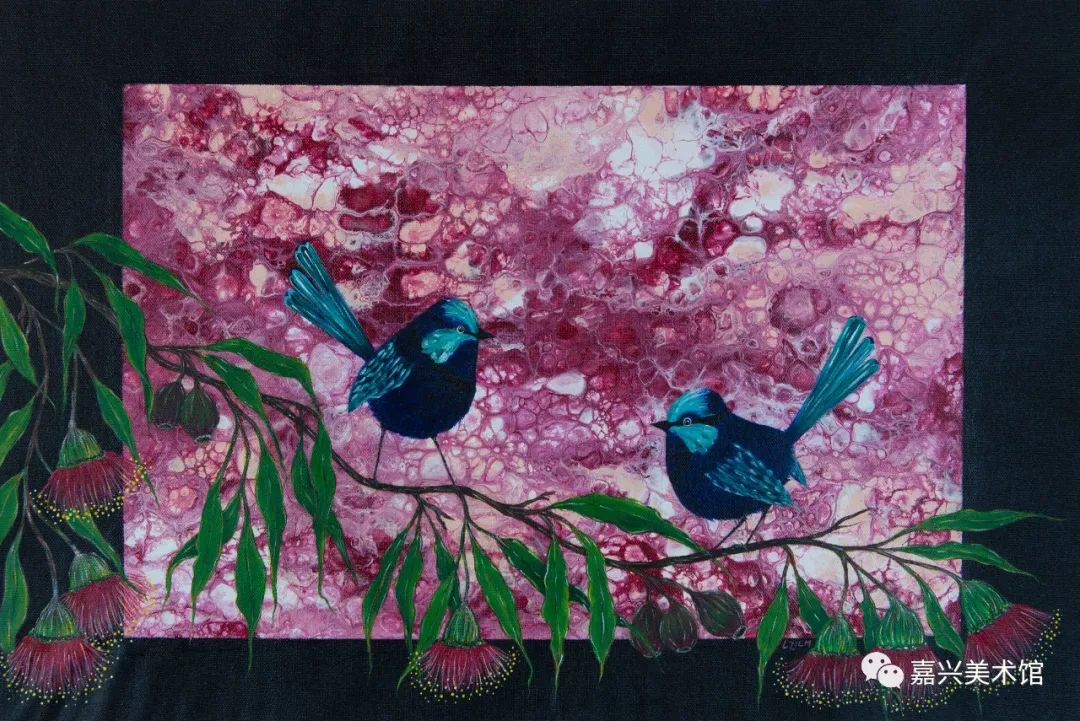
作者:Leanne Zilm
作品:壮丽细尾鹩莺(雀鸟)
作者是西澳大利亚州西南地区传统部落的后裔。作者的家乡位于菲茨杰拉德国家公园附近。在家乡生活的经历给作者带来了难忘的快乐和喜悦。作者喜欢游览这座公园,欣赏绽放的野花,观察穿梭在花丛、树丛中的飞鸟。作者的创作灵感来源于其经常观察的一只雀鸟——壮丽细尾鹩莺。这种鸟的行踪难以捉摸,只有在有同伴的时候,才会离开生活的灌木丛,外出寻找食物。传说中,雄性飞鸟有两个伴侣,他们互相照顾、共同筑巢、养育后代,并协力抵御食雀鹰的袭击。在当地文化中,这种飞鸟被视为是一种幸运的象征。
Leanne Zilm
The Ter – Ter
My name is Leanne Zilm and I am a descendant of the Wudjari and Goreng Noongar tribal groups of the southwest of Western Australia. Being on Noongar country fills me with great happiness and joy, especially when I go home to Wudjari country at Bremer Bay near the Fitzgerald National Park; one of Australia's most scenic and botanically significant parks. There are so many amazingly beautiful flowering plants in the park that attract the nectar and insect eating birds. I love to sit and watch them flitting between the flowers, bushes and trees.
The inspiration for my artwork is the bird that I watch out for the most, the little blue Splendid Fairy Wren or Ter-Ter in our Noongar language. The Ter-Ter is very elusive and doesn't come out of the bush very often but when he does his family is with him. They jump around on the ground looking for insects but quickly jump back into the bush again.
The Noongar legend from long ago says the male Ter-Ter had two wives and they shared their labours in nest building, and in hatching and feeding the young, while the husband took care of them. They had to be careful of Cootup the Sparrowhawk because he liked to eat the little ones, which is why they are so elusive and not often seen.

作者:Lera Bennell
作品:剪影
作者是地区受人尊敬的原住民长老,她的父母亨利·贝内尔、维奥莱特·贝内尔共养育了十个孩子。由于父亲的工作关系,童年时代的作者经常搬家,她先后住过达坎地区的营地、帐篷和旧福利院。他们居住的简易房子只有2间卧室、一间厨房,厨房还没有自来水,他们每天需要到门前花园的水龙头取水。努加族原住民保护区都建有淋浴房和厕所。保护区内建造了方形或长方形的淋浴间、厕所和公共清洗池。
Lera Bennell
Minimalism
Hi, my name is Lera Bennell from Bunbury W.A I am a Wilman- Wadandi Elder.I am one of 10 children from parents Henry and Violet Bennell [Dec].
During my childhood we moved around the South West, Noongar Country, as my father was a labourer and worked on farms and railways. We lived in tin camps, tents and old native welfare houses in Darkan. The houses consisted of cemented floors, 3 rooms only. 2 bedrooms and a kitchen with no running water. We used the garden tap near the entrance to the house. Toilet block. Wash trough.
All Noongar reserves built the ablution showers and toilet blocks.
At Pingelly Reserve - Cement blocks were made and built in squares and rectangles for showers and toilets and wash troughs for our people, I see this minimalisation of architecture equivalent to a minimalisation of our culture.
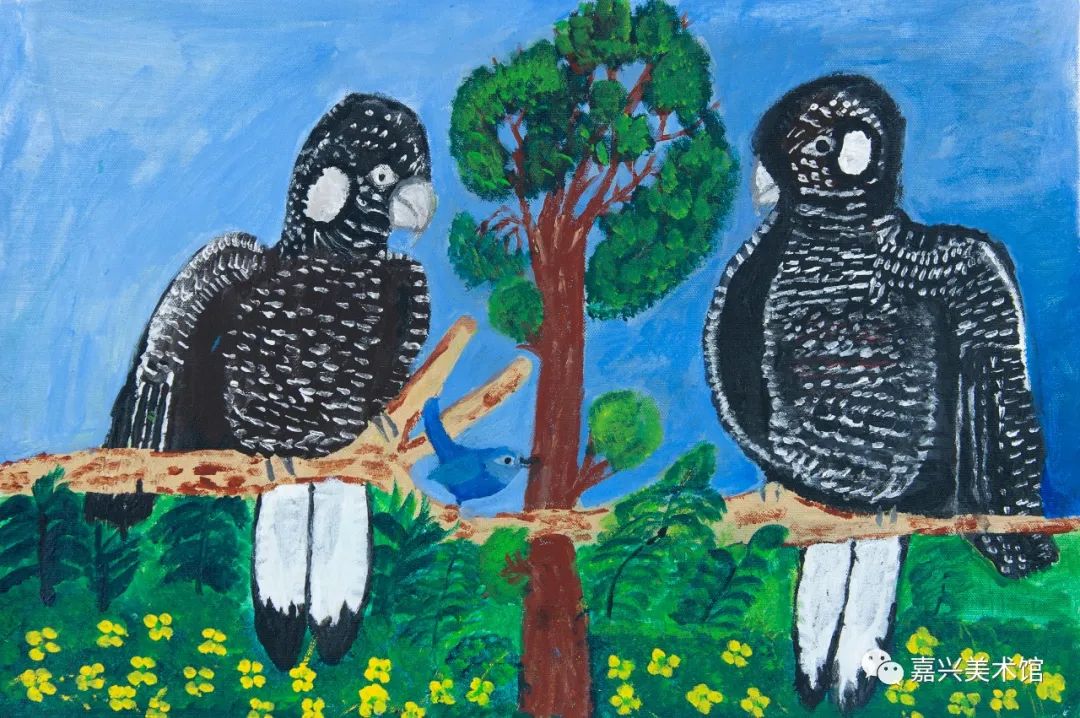
作者: Marjorie Ugle
作品:红尾黑凤头鹦鹉
该作品描绘了红尾黑凤头鹦鹉在野花季节采食的画面。作品中的鹦鹉是西澳州西南地区的鸟类,羽毛色泽丰富,尾部呈现白色、红色、黄色或灰色。野花季是重要的原住文化符号,通常在8至9月,满山的野花、坚果为红尾黑凤头鹦鹉提供了充足的食物。作品中的树木是当地常见的班克木、红千层树。
Marjorie Ugle
Karrak – Cockatoo
They are either White tails, Red Tails or Yellow and Grey. They are South West native birds.
Djeran is the season of the wildflowers.
Djeran is August and September. Karrak eat wildflowers, our trees are Banksia and Bottlebrush. Karrak eat the nuts and seeds.
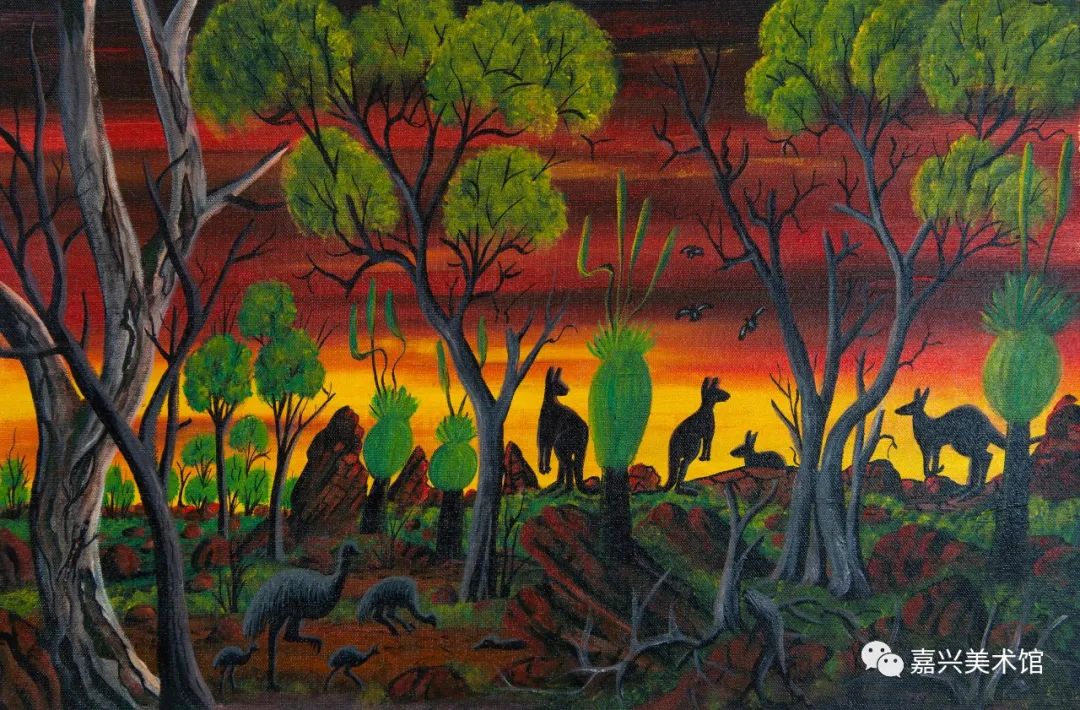
作者:Phillip Hansen
作品:夕阳下的灌木丛
很多动物和鸟类都栖息在澳大利亚的灌木丛中,如鸸鹋、蜥蜴、凤头鹦鹉等。作者在奔走创作过程中,常常被灌木丛的独特美所吸引。在作品中,作者将见到的灌木丛场景进行了叠加,并使用鲜艳的颜色来展示家乡灌木丛的美景。画作描绘了日落时分动物和鸟类吃完食物后准备回巢的场景。作者擅长绘制桉树、石头和各种动物,在创作过程中,作者希望观众能跟随他的视角,去观察灌木丛中的蜥蜴等各种小动物。比较有意思的是,当人们发现小动物时,它们早已注视了人们很久了。
Phillip Hansen
Australian Bush at Sunset
Kangaroo, Emu, Lizards, Cockatoo- animals and birds that are all living and part of our Australian Bush.
I love to paint, it takes me to a peaceful space where I am travelling through country and being amazed by the living beauty, colour and space of our bush.
My paintings don't have to be a particular place, they are a combination of everywhere I have been and imagine. I love to use strong vibrant colours to show my country. At sunset the animals and birds start to move, have a last feed and take shelter for the night.
My works always have eucalyptus trees, rocks and animals. I try to capture a lizard on a rock or up a tree, so you look for him, just like when you are in the bush and suddenly find one watching!
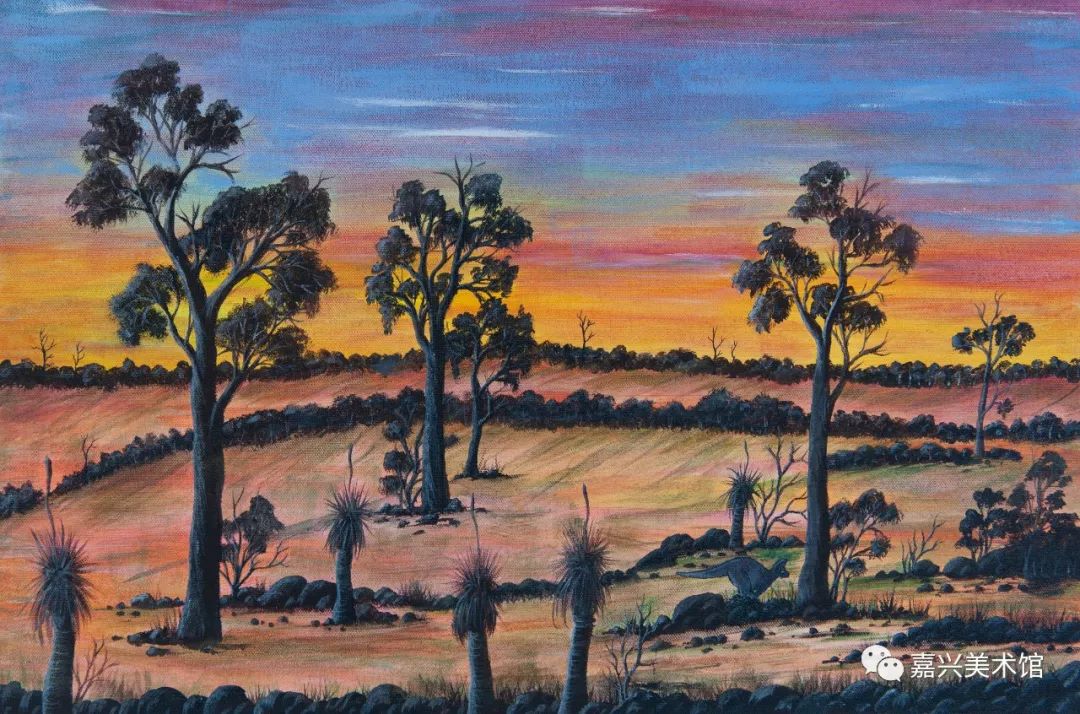
作者:Rhona Wallam
作品:暮光
作者是努加族地区受人尊敬的原住民长老,擅长观察别人作画,并从中汲取了丰富经验。作者擅长在自己的作品中注入丰富的色彩。在创作生涯中,他常常向孩子们和社区组织传授绘画知识和技巧。丰富的颜色为其创作注入了无穷灵感。在这幅作品中,作者通过运用丰富的色彩搭配,使故乡的寻常景物跃然纸上。
Rhona Wallam
The Evening Light
A Wilman, Wardandi Elder. I loved watching people paint and I learnt a lot just watching. Now I just like messing around with paint, and I like using a lot of colour.
I have painted and given Art lessons to children and community groups throughout my painting life.
I love owning the colour, colour inspires me.
The landscapes do not have to be a particular place: it is a scene that flows through me in a celebration of country.
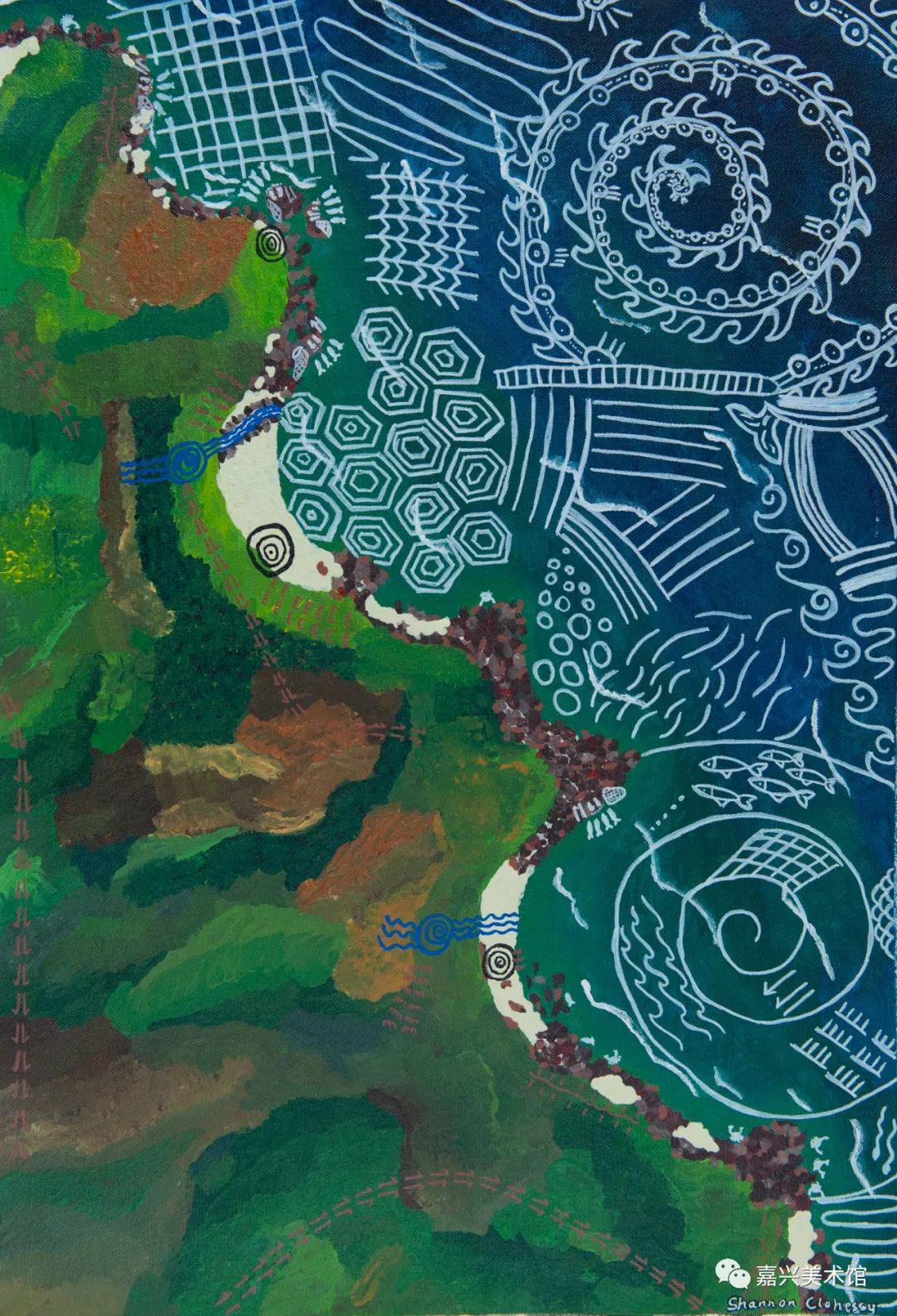
作者:Shannon Clohessy
作品:家庭乐符
作品表达了作者与家乡、家庭的紧密联系。作为一个生活在努加地区的居民,蜿蜒的海岸和起伏的波浪令作者心旷神怡。作品中的海岸是作者第一次接触海洋的地方。小时候,他们经常去海边露营、玩耍。母亲在作者只有几个月大时已经带她在海里游泳。这幅作品以乐符的形式,描绘了作者与其家人常去的海边,记录了兄弟姐妹在石块上搭建的“城堡”,以及长辈们钓鱼的地方等。童年的记忆给作者留下了印象,也加深了她对自身、家庭、国家,以及海洋的认识。
Shannon Clohessy
Moort Kwala – Family Song Lines
As a Wadandi yorga –saltwater woman these places along the coast and in the break of the waves is where I feel most at home.

这幅作品主要采用原住民旗帜的颜色:红色、黄色和黑色,红色代表土地和血液,黄色代表太阳,黑色代表肤色。作者希望通过这幅作品,展示原住民文化如何植根于他们的生活。在画面的前景,作者绘制了鸸鹋和袋鼠,这两种动物是澳大利亚的国家象征,后面的黑天鹅则象征着西澳大利亚州。画中演奏迪吉里杜管(澳大利亚原住民传统木管乐器)的乐手是作者的化身,通过全身心投入的演奏,表现其对自身文化的热爱。作者希望通过这幅画,展现当代原住民艺术家的创作风貌。未来,作者希望通过自身的艺术实践,与更多的艺术爱好者建立联系,进一步传授原住民文化。
Stephen TaylorLooking at the foreground you have the Emu and Kangaroo two native animals that are the national Australian emblems. The Black Swan being the Western Australian emblem.
The didgeridoo player represents me and my immersion in the total way of being aboriginal now of this country.
The stars constellation is the Union Jack and the Southern Cross on the Australian flag!
This painting represents me as an artist in living culture now. Looking to the future, I aim to connect with people and educate in cultural knowledge through my art practice.
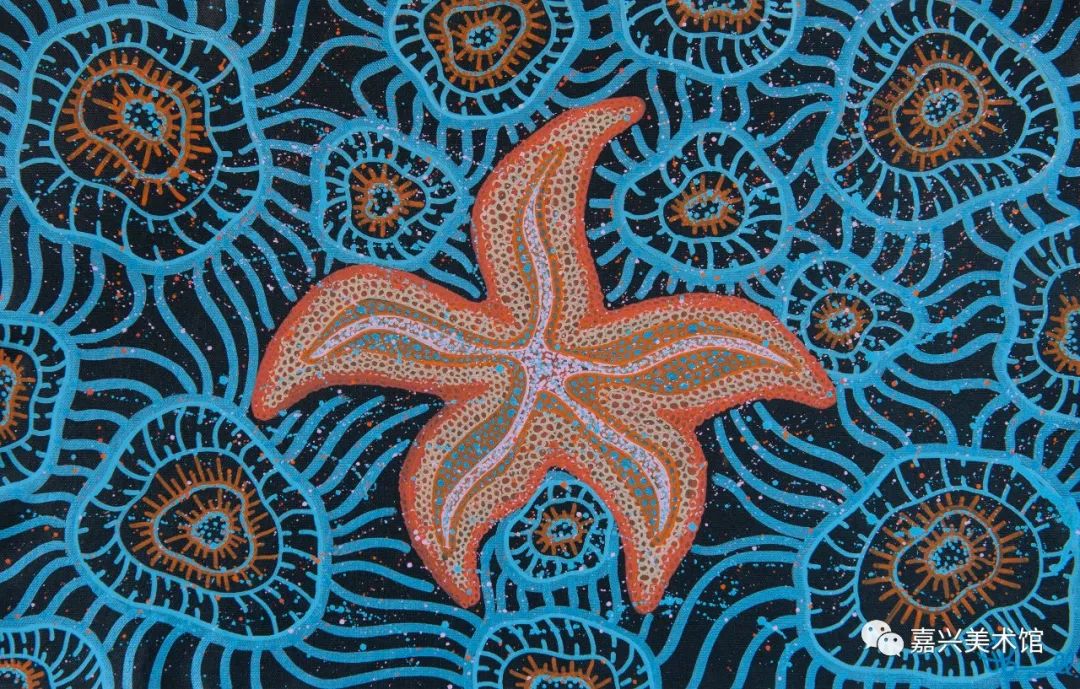
作者:Tahlia Bennell
作品:梦境中的海星
Djinda Djildjit 是原住民语言,代表海星。作者作为一位原住民艺术家通过对自己过往经历的回溯和对未来的展望,表达对故土和海洋的深沉感情。
Tahlia Bennell
Djinda Djildjit Dreaming Maambakoort Coral Connection / Starfish Dreaming Saltwater Connection
It is based on my journey past, present and future as a noongar artist and my connection to noongar land and sea.
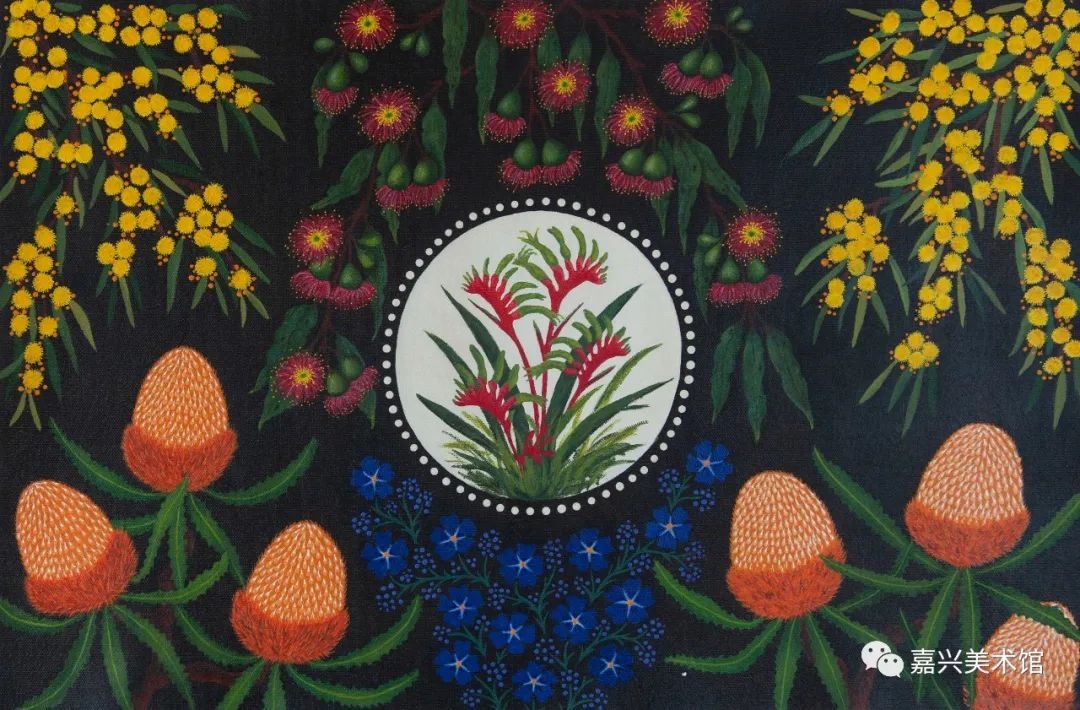
作者:Tracy Bellotti
作品:Boodja 的野花
作者是西澳大利亚州西南地区努加部落的后裔。千百年来,澳大利亚原住民为了生存,逐渐形成了对自然环境的深刻认识,并与陆地海洋、天空、河流地区、季节以及动植物建立了紧密联系。非原住民可能难以理解这种联系。他们对土地、环境的深刻认识超越了物理范畴,升华为一种精神上的纽带,原住民相信万物相联,包括过去、现在、人类、土地、海洋以及所有的动植物。作者的创作灵感来源于对家园的热爱,他常常驻足欣赏当地美丽的风景和动植物,在最佳精神状态下进行艺术创作。澳大利亚有2.4万种植物,这些植物是宝贵的资源,该作品描绘了西南地区当地常见的植物品种。
金合欢(pycnanth):澳大利亚的花卉象征
袋鼠爪花(manglesii):西澳大利亚州的花卉象征
Tracy Bellotti
Noongar Boodja Wildflowers
Over thousands of years, Aboriginal people in Australia formed a deep understanding of the natural environment in order to survive. The deep connection with 'Country' – the land, sea, sky, rivers, sites, seasons, plants and animals that surround us, can be a difficult concept for non-Aboriginal people to grasp. Our relationship with the land and the living environment goes beyond physical elements; there is a spiritual intimacy associated with the land, which remains fundamental to the identity and way of life of many of our people. It is the belief that everything is connected, the past, the present, the people, the land, the sea and all of its plants and animals; it is holistic and all-encompassing.
There are an astounding 24,000 species of native plants in Australia. My artwork depicts five common species that grow in the south west Noongar region of Western Australia.
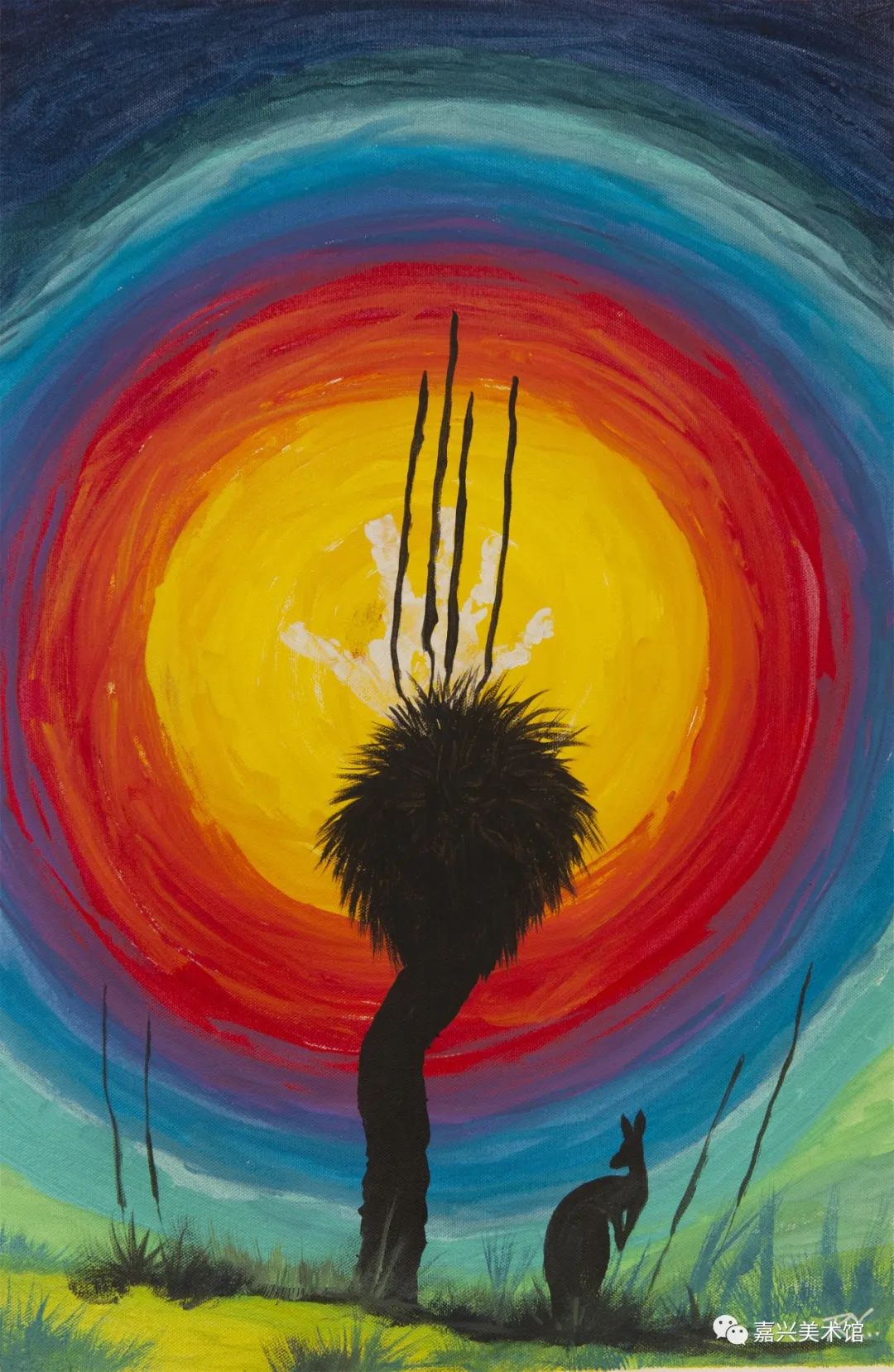
作者:Troy Bennell
作者年轻时曾参加首批赴中国的努加族艺术作品展,并在嘉兴展示了他的艺术作品,表演了原住民舞蹈,演奏了传统乐器迪吉里杜管(澳大利亚原住民传统木管乐器)。中国行期间,作者与当地居民进行了友好交流,并到访了两市友好林。20年过去了,身为祖父的作者为纪念两个城市的友好情谊创作了这幅作品。作品中植物上的四个花蕊代表了其四个女儿,手印为其孙女的手印,用以展示家庭的基因。背景中的六种颜色,代表了原住民文化中的六个季节。画面中的植物是力量的象征,寓意两个城市间紧密的联系。
Troy Bennell
I met with local people and saw the garden there in honour of Bunbury.
Acknowledgements
The City of Bunbury would like to acknowledge the Wardandi Noongar People as the traditional custodians of the land we are situated on, and pay our respects to elders past, present and future. We would also like to acknowledge the following organisations, groups and people for their contribution to making this exchange of cultures a reality.
Jaysen Miguel, Mayor of Bunbury
致 谢
努加族原住民一直以来守护着我们赖以生存的土地,班布里市对此表示感谢,并向过去、现在和将来的长老致以敬意。我们还要感谢以下组织、团体和个人,他们为促成本次文化交流作出了积极贡献。
澳大利亚班布里市市长杰森·米格尔
班布里地区美术馆努加族艺术协调员凯伦·摩根
澳大利亚班布里市
中国浙江省嘉兴市
原住民视觉艺术产业支持机构
